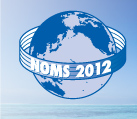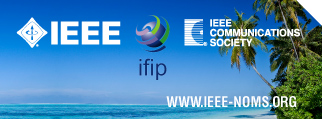| |
TUTORIALS
Tutorial T1: Towards Network Innovation through OpenFlow/SDN
Monday, 8:45am-12:15pm, April 16, 2012
Speaker: Masayoshi Kobayashi (Stanford/NEC, USA)
Abstract:
Software-defined networking (SDN) is an emerging paradigm that has been drawing significant interestsboth from industries and academia. SDN provides network owners and operators with more evolvable, flexible networks, in the data center, cellular network, enterprise, and home. Key attributes of SDN include: separation of data and control planes; a uniform vendor-agnostic interface between control and data planes called OpenFlow; a logically centralized control plane; and slicing and virtualization of the underlying network. With an SDN, a researcher or network administrator can introduce a new capability by writing a simple software program that manipulates the flows within a logical slice of the network.
This tutorial consists of two parts. The first part provides an overview of SDN: the concept,various components including OpenFlow switch, OpenFlow protocol, Network OS, control and management application on top, OpenFlow ecosystem (including various vendors and service providers) and OpenFlowdeployment projects in the world (including US GENI project). OpenFlow network in your LabsYou will see some demos (recorded) that demonstrates interesting applications developed in Stanford University and some real-time statistics of OpenFlow network running at Stanford. The second part is a brief introduction of OpenFlow/SDN programming and deployment, where you will learn how to setup an OpenFlow-enabled network on your laptop (using VM), in your Lab or in your campus, and learn how to write a basic application (layer2 learning switch network) with open source OpenFlow controllers. You will also learn some usefulprogramming tools (mininet, OpenFlow wireshark) that helps you to evaluate and debug your OpenFlow/SDN application.
After attending this tutorial, you will understand the concepts of OpenFlow/SDN, various components,and possible research ideas and will have enough knowledge to build your own OpenFlow/SDN networkas well as to start writing your application on top of it.
Speaker’s Biography:
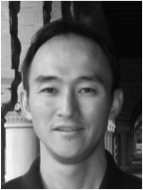 Masayoshi Kobayashi received his Bachelor's and Master's engineering degrees from Kyoto University, Japan in 1995 and 1997, respectively. In 1997, he joined NEC and became involved in research including high-speed routers, contents-delivery network, and network measurements. From 2003 to 2004, he was with Prof. Nick McKeown’s group at Stanford as a visiting researcher from NEC and was involved in TCP congestion control research. Since 2007, he again has been with Prof. Nick McKeown’s group at Stanford as a visiting researcher from NEC, where he was one of the first to be involved in the OpenFlow project, leading the mixed wired and wireless production deployment at Stanford, in addition to contributing to award-winning OpenFlow demos at SIGCOMM in 2008 and 2009, and Mobicom 2009. He has been also involving in US GENI project, where he was helping deploying OpenFlow networks in eight campuses and two national research backbone (Internet2 and National Lambda Rail). Masayoshi Kobayashi received his Bachelor's and Master's engineering degrees from Kyoto University, Japan in 1995 and 1997, respectively. In 1997, he joined NEC and became involved in research including high-speed routers, contents-delivery network, and network measurements. From 2003 to 2004, he was with Prof. Nick McKeown’s group at Stanford as a visiting researcher from NEC and was involved in TCP congestion control research. Since 2007, he again has been with Prof. Nick McKeown’s group at Stanford as a visiting researcher from NEC, where he was one of the first to be involved in the OpenFlow project, leading the mixed wired and wireless production deployment at Stanford, in addition to contributing to award-winning OpenFlow demos at SIGCOMM in 2008 and 2009, and Mobicom 2009. He has been also involving in US GENI project, where he was helping deploying OpenFlow networks in eight campuses and two national research backbone (Internet2 and National Lambda Rail).
Tutorial T2: Cloud Enablement Services: Technologies and Challenges
Monday, 8:45am-12:15pm, April 16, 2012
Speakers: Ajay Mohindra (IBM Research, USA), Sambit Sahu (IBM Research, USA), Kunwadee Sripanidkulchai (NECTEC, Thailand)
Abstract:
Cloud computing has evolved in recent years from providing basic on-demand computing resources to supportingand enabling high value services for application providers such as Elastic Computing, Scalable Storage, Big Data Analytics, disaster recovery,availability and backup services. This tutorial will focus on some of these keyservices enabled and supported in a cloud – covering both hands-on technologies as well as recent advancementsin these areas. This tutorial consists of three parts. The first part of the tutorial will introduce and build upon hands-on exposition ofIaaS Cloud basics to cover how elasticity is supported at a resource as well as a platform level. We shall expose theaudience to these concepts through illustration of real cloud technologies such as OpenStack, Amazon (AutoScale,ELB, Beanstalk based services) and Google App Engine (web application framework for elasticity). The second partof the tutorial will focus on the cloud enablement services – several key services that are required (beyondon-demand resources) to support enterprise or domain specific applications. Specifically, we shall present thecurrent trends and research challenges for security, multi-tenancy, scalability, availability, and disaster recoveryrequirements for application enablement on cloud. The third part of the tutorial will focus on extremely large scalenetwork and analytic services including key innovations in the area of data center network configuration and designto support extreme scale and security/isolation related configuration issues.
Speakers' Biography:
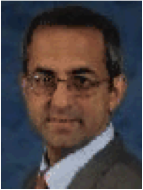 Ajay Mohindra has been a research staff member at IBM since 1993 and a research staff manager since 2005. For his technical contributions to IBM, he has been received one Outstanding Innovation Achievement Award, one Outstanding Technical Achievement Award, two Research Division Awards, and one Technical Group Award. He also holds 16 patents. He holds a Ph.D. in computer science from the Georgia Institute of Technology. His research interests include distributed systems management and cloud computing. Dr. Mohindra’s research has been the foundation for the cloud provisioning solution for IBM Cloud offerings. Ajay Mohindra has been a research staff member at IBM since 1993 and a research staff manager since 2005. For his technical contributions to IBM, he has been received one Outstanding Innovation Achievement Award, one Outstanding Technical Achievement Award, two Research Division Awards, and one Technical Group Award. He also holds 16 patents. He holds a Ph.D. in computer science from the Georgia Institute of Technology. His research interests include distributed systems management and cloud computing. Dr. Mohindra’s research has been the foundation for the cloud provisioning solution for IBM Cloud offerings.
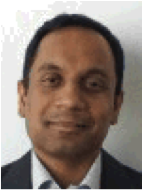 Sambit Sahu has been a research staff member at IBM since 2000. Dr. Sahu received his Ph.D. degree in Computer Science from University of Massachusetts at Amherst. After joining IBM Research, Dr. Sahu has focused on systems and network services management, content distribution network and data center networking and more recently on cloud computing and smarter planet solutions. He has more than 50 technical papers and 60 patents filed in these areas. He is the founding chair of Usenix/ACM HotClpoud workshop which has been well received in the Cloud/Systems community. Dr. Sahu has a best paper award at ACM Internet Measurement Conference 2006. Dr. Sahu’s recent research has been on designing cloud platform and solutions for deploying smarter city services at city-wide scale. He is a master inventor at IBM Research and has Outstanding Achievement Award and Research Division Awards for his pioneering work in these areas. Sambit Sahu has been a research staff member at IBM since 2000. Dr. Sahu received his Ph.D. degree in Computer Science from University of Massachusetts at Amherst. After joining IBM Research, Dr. Sahu has focused on systems and network services management, content distribution network and data center networking and more recently on cloud computing and smarter planet solutions. He has more than 50 technical papers and 60 patents filed in these areas. He is the founding chair of Usenix/ACM HotClpoud workshop which has been well received in the Cloud/Systems community. Dr. Sahu has a best paper award at ACM Internet Measurement Conference 2006. Dr. Sahu’s recent research has been on designing cloud platform and solutions for deploying smarter city services at city-wide scale. He is a master inventor at IBM Research and has Outstanding Achievement Award and Research Division Awards for his pioneering work in these areas.
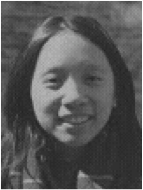 Kunwadee (Kay) Sripanidkulchai is a senior researcher at the National Electronics and Computer Technology Center (NECTEC) in Thailand.Her research interests are in services delivery, cloud computing, and networking. In her previous role, she was a Research Staff Member at the IBM T.J. Watson Research Center exploring the technical and business challenges of migration into clouds and virtualized environments, and enabling live migration across data centers. Kay led a team of IT architects in IBM Global Technology Services to develop new processes and tools for a new virtualization service offering for IBM. She has co-authored a number of papers and patents in networking and cloud computing, and has taught at several universities including Columbia University, Mahidol University, Khonkaen University and Thammasat University. She was awarded a Ph.D. from the Department of Computer and Electrical Engineering at Carnegie Mellon University in 2005 where she was advised by Hui Zhang and Bruce Maggs. Kunwadee (Kay) Sripanidkulchai is a senior researcher at the National Electronics and Computer Technology Center (NECTEC) in Thailand.Her research interests are in services delivery, cloud computing, and networking. In her previous role, she was a Research Staff Member at the IBM T.J. Watson Research Center exploring the technical and business challenges of migration into clouds and virtualized environments, and enabling live migration across data centers. Kay led a team of IT architects in IBM Global Technology Services to develop new processes and tools for a new virtualization service offering for IBM. She has co-authored a number of papers and patents in networking and cloud computing, and has taught at several universities including Columbia University, Mahidol University, Khonkaen University and Thammasat University. She was awarded a Ph.D. from the Department of Computer and Electrical Engineering at Carnegie Mellon University in 2005 where she was advised by Hui Zhang and Bruce Maggs.
Tutorial T3: Disaster Recovery on Network Infrastructure: Focused on the Earthquake in Japan
Monday, 1:45pm-5:15pm, April 16, 2012
Speakers: Hideaki Kimura (NTT, Japan), Yukio Ito (NTT Communications, Japan), Keizo Sugiyama (KDDI R&D Laboratories, Japan), Tohru Asami (The University of Tokyo, Japan)
Abstract:
The 2011 earthquake of the Pacific coast of Tohoku and the successive tsunami occurred on March 11th, 2011, which is biggest one in modern era in Japan, disabled the communication infrastructure within Tohoku as well as trunk lines to those areas. We learned various things through this disaster, so we think that we must use this experience to R&D effectively. This tutorial mainly consists of major three parts. 1) Damage and Restoration of Backbone Networks Regarding the Great East Japan Earthquakes, 2) Power Control Technology for Disaster Resistant Base Stations, and 3) Fault Tolerance of Modern Telecommunication Network - Known problems are unsolved yet.
First, this tutorial introduces quake-caused damage situation and how we have done for restoration from the disaster. Especially, telecommunication facilities were suffered large-scale damage by tsunami. Now communication system is a most important lifeline as everyone recognizes, so we must keep communication systems in any situations as a communication career’s mission. This tutorial introduces overview of east Japan earthquake including discovery situation, measures, and future technologies for important 4 research fields related access network technologies such as ‘basic equipment’, ‘optical fibers’, ‘wired transmission’, and ‘wireless transmission’ considering disaster resistance improvement.
Next, this tutorial introduces tribrid power control technology for realizing power supplies that reduce CO2 emissions. This technology enables estimated reductions of 20% to 30% in both commercial electric power consumption and CO2 emissions in base stations and also contributes to deploying disaster-resistant base stations.
Finally, this tutorial quantitatively analyzes the fault tolerance of the today's telecommunication network against this large quake, comparing other social infrastructures, and shows some trivial technologies are not implemented yet, which may increase the service continuity. The issues are launched on failure-resistant networks utilizing their remaining network resources at maximum and providing the services by the same user interfaces as usual even in such a disaster.
Speakers' Biography:
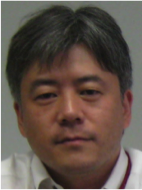 Hideaki Kimura received the B.E. and M.E. and Ph.D. degrees in electrical engineering from Hokkaido University, Sapporo, Japan, in 1987, 1989, and 1992, respectively. In 1992, he joined NTT LSI Laboratories, Kanagawa, Japan, where he engaged in research on package design for 100Gb/s level high-frequency wideband ICs and high-sensitivity receiver module design for optical subscriber systems. From 1994 to 1996, he was at the NTT Transmission Systems Laboratories, Kanagawa, Japan, where he engaged in research on economical system such as LD transceiver, PD transceiver techniques. Since 1996, he has been engaged in research on super-low-power transceiver module for optical subscriber system, system design and basic technologies such as 1V-operation-super-small-size ONU and no-power-supply voice communication service for black out situation due to disaster. Furthermore, he has been researched future optical access network systems based on WDM and DSP. From 2010, he is an executive research engineer at research & development planning section, NTT Access Network Service Systems Laboratories. He is a member of IEEE and IEICE. Hideaki Kimura received the B.E. and M.E. and Ph.D. degrees in electrical engineering from Hokkaido University, Sapporo, Japan, in 1987, 1989, and 1992, respectively. In 1992, he joined NTT LSI Laboratories, Kanagawa, Japan, where he engaged in research on package design for 100Gb/s level high-frequency wideband ICs and high-sensitivity receiver module design for optical subscriber systems. From 1994 to 1996, he was at the NTT Transmission Systems Laboratories, Kanagawa, Japan, where he engaged in research on economical system such as LD transceiver, PD transceiver techniques. Since 1996, he has been engaged in research on super-low-power transceiver module for optical subscriber system, system design and basic technologies such as 1V-operation-super-small-size ONU and no-power-supply voice communication service for black out situation due to disaster. Furthermore, he has been researched future optical access network systems based on WDM and DSP. From 2010, he is an executive research engineer at research & development planning section, NTT Access Network Service Systems Laboratories. He is a member of IEEE and IEICE.
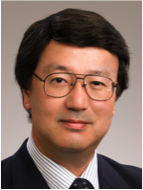 Yukio Ito is a Vice President and Executive Manager in NTT Communications. He joined in Nippon Telegraph and Telephone Public Corporation in 1983. He has designed architecture of Transmission Network of NTT, has introduced new technology in Transmission Network of NTT. After reorganization of NTT in 1999, he was in charged of engineering, construction and operation of IP & L2 backbone network in NTT Communications. At present, he is in charge of the entire NTT Communications service infrastructure. Yukio Ito is a Vice President and Executive Manager in NTT Communications. He joined in Nippon Telegraph and Telephone Public Corporation in 1983. He has designed architecture of Transmission Network of NTT, has introduced new technology in Transmission Network of NTT. After reorganization of NTT in 1999, he was in charged of engineering, construction and operation of IP & L2 backbone network in NTT Communications. At present, he is in charge of the entire NTT Communications service infrastructure.
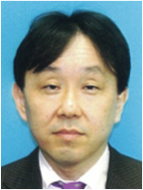 Keizo Sugiyama received the B.S. and M.S. degreesin Information Science from Kyoto University in 1985, 1987 respectively. He received Ph.D in Informatics from Kyoto University in 2004. He joined KDD R&D Laboratories in 1987 and has engaged in the researches on OSI protocols, Electronic Data Interchange (EDI), network management, Intelligent Transport Systems (ITS) and Wireless LAN. He is currently an executive director at KDDI R&D Labs. Keizo Sugiyama received the B.S. and M.S. degreesin Information Science from Kyoto University in 1985, 1987 respectively. He received Ph.D in Informatics from Kyoto University in 2004. He joined KDD R&D Laboratories in 1987 and has engaged in the researches on OSI protocols, Electronic Data Interchange (EDI), network management, Intelligent Transport Systems (ITS) and Wireless LAN. He is currently an executive director at KDDI R&D Labs.
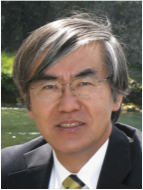 Tohru Asami received B.E. degree and M.E. degree in electrical engineering from Kyoto University in 1974 and 1976 respectively, and Ph.D. from University of Tokyo in 2005. In 1976, he joined KDD (KDDI). Since that time, he has been working in several research areas such as UNIX-based data communication systems, network management systems, etc. After C.E.O. of KDDI R&D Labs. Inc., in 2006, he moved to The University of Tokyo as a professor of Dept. of Information and Communication Engineering, Graduate School of Information Science and Technology. He is a member of the IEEE. From 2003 to 2005, he was a vice chairman of the board of directors of Information System Society in The Institute of Electronics, Information and Communication Engineers, Japan (IEICE-ISS). Tohru Asami received B.E. degree and M.E. degree in electrical engineering from Kyoto University in 1974 and 1976 respectively, and Ph.D. from University of Tokyo in 2005. In 1976, he joined KDD (KDDI). Since that time, he has been working in several research areas such as UNIX-based data communication systems, network management systems, etc. After C.E.O. of KDDI R&D Labs. Inc., in 2006, he moved to The University of Tokyo as a professor of Dept. of Information and Communication Engineering, Graduate School of Information Science and Technology. He is a member of the IEEE. From 2003 to 2005, he was a vice chairman of the board of directors of Information System Society in The Institute of Electronics, Information and Communication Engineers, Japan (IEICE-ISS).
Tutorial T4: Model-driven Semantic Management
Monday, 1:45pm-5:15pm, April 16, 2012
Speaker: Joel Fleck II (HP, USA)
Abstract:
The highly adaptive and distributed nature of emerging service delivery environments such as SOA or Cloud SaaS, mean that it is impossible to accurately predict the precise nature of the interactions a software component may be involved in or even the resources that may be used. As a result, management systems cannot reliably have any knowledge of the precise events, entities or actions required to perform management activities. Furthermore, the potential of a large number of widely distributed providers supplying component services and/or resources means that single source management is infeasible. One solution to these challenges is to construct a system of highly federated management environments that are both semantically aware of neighboring environments and use context of federation in management decisions. This tutorial will detail the challenges presented with a highly distributed network of management systems and provide a detailed example of a methodology to build and manage semantic, context-aware inter-domain relationships. It is anticipated that upon conclusion participants will be able to understand the methodology and a sample of tools needed to model a business environment from a consumers perspective, validate semantic integrity of inter-operating business environments, and transform concept maps representing the business perspective into business models, technology neutral architectural models, and technology specific perspectives.
Speaker’s Biography:
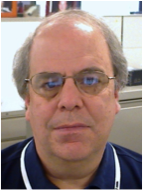 Joel J. Fleck II is Chief Architect in the HP Software CTO organization with primary research focuses on architectures for adaptive management of distributed systems and policy based management. He also serves as Head of Standards for HP Software. Previously, he spent 16 years at Bell Laboratories and Bell Communications Research researching distributed management systems, multimedia networks and automated test systems. Joel is the author or co-author of numerous papers on advanced distributed management systems, was Chief Architect for the TeleManagement Forum NGOSS Architecture, has presented numerous keynotes on the policy-based management and distributed management system, and has chaired or co-chaired numerous workshops and conferences dealing with adaptive, policy-based management architectures. He serves in executive and expert roles with a number of international standards bodies and standards defining organizations. Joel graduated from the University of Michigan with a MS in Industrial and Operations Engineering (focus on large-scale system design) and the University of Vermont with a BS in Computer Science, with co-ordinate majors in Electrical Engineering and Environmental Engineering. He is Distinguished Fellow of the TeleManagement Forum. Joel J. Fleck II is Chief Architect in the HP Software CTO organization with primary research focuses on architectures for adaptive management of distributed systems and policy based management. He also serves as Head of Standards for HP Software. Previously, he spent 16 years at Bell Laboratories and Bell Communications Research researching distributed management systems, multimedia networks and automated test systems. Joel is the author or co-author of numerous papers on advanced distributed management systems, was Chief Architect for the TeleManagement Forum NGOSS Architecture, has presented numerous keynotes on the policy-based management and distributed management system, and has chaired or co-chaired numerous workshops and conferences dealing with adaptive, policy-based management architectures. He serves in executive and expert roles with a number of international standards bodies and standards defining organizations. Joel graduated from the University of Michigan with a MS in Industrial and Operations Engineering (focus on large-scale system design) and the University of Vermont with a BS in Computer Science, with co-ordinate majors in Electrical Engineering and Environmental Engineering. He is Distinguished Fellow of the TeleManagement Forum.
Tutorial T5: Cloud computing for Scalable Network Management
Friday, 8:45am-12:15pm, April 20, 2012
Speaker: Jérôme François (University of Luxembourg, Luxembourg)
Abstract:
Cloud computing offers a smart way to deal with highly resources consuming tasks by leveraging distributed processing on a cluster of machines. Nowadays, such tasks include also network management related ones, especially due to large volumes of network data to deal with and complex operations to achieve for gaining knowledge about data. This tutorial will introduce cloud-computing related paradigms and technologies. In particular, it will focus on Map-Reduce, initially introduced by Google, which the popularity has highly increased recently. Map-Reduce has shift the way to process large volumes of data by executing the code where the data is, and not by downloading the data where the code is. This is very helpful for analyzing large volumes of data like ones generated by network (packet capture, logs, Netflows,...) which may be captured, even in high speed networks, but which the volume limits their analysis. Deep analysis raises important issues. First, this is a task consuming. Thus, the results may be provided too late to be exploited. Finally, large storage space is required since, during the analysis, prior data has to be kept and storing new one is necessary.
Speaker’s Biography:
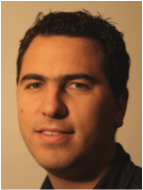 Jérôme François is a Research Associate at the University of Luxembourg - Centre for Security, Reliability and trust. He obtained his Ph.D. on robustness and identification of communicating applications from the Université Henri Poincaré in Nancy France, in December 2009. In 2006, he obtained a Masters diploma in computer research and was graduated from ESIAL (École Supérieure d’Informatique et ses Applications de Lorraine), a french leading school in computer science in Nancy. His main research interests are related to security and privacy including large scale anomaly detection, fingerprinting, security in vehicular networks, cloud computing and digital forensics. Jérôme François is a Research Associate at the University of Luxembourg - Centre for Security, Reliability and trust. He obtained his Ph.D. on robustness and identification of communicating applications from the Université Henri Poincaré in Nancy France, in December 2009. In 2006, he obtained a Masters diploma in computer research and was graduated from ESIAL (École Supérieure d’Informatique et ses Applications de Lorraine), a french leading school in computer science in Nancy. His main research interests are related to security and privacy including large scale anomaly detection, fingerprinting, security in vehicular networks, cloud computing and digital forensics.
Tutorial T6: Towards Holistic Green Communications and Network Management
Friday, 8:45am-12:15pm, April 20, 2012
Speakers: Konstantinos Samdanis (NEC Europe, Germany), Dominique Dudkowski (NEC Europe, Germany)
Abstract:
Our tutorial presents and analyzes the main technical principles and most significant technical proposals in green communications and networking management. The tutorial considers both generic concepts as well as detailed studies of energy management techniques in wireless and wired networks. Two specific use cases, one wireless and one wired, are presented to illustrate the application of green management concepts more concretely. An outlook on more holistic applications of energy management in communication networks concludes the tutorial. The main goal of the tutorial is to equip practitioners and researchers alike with the most fundamental principles to energy management in communication networks, so that they can successfully apply them in their practical, technical, and scientific context. An important objective is to provide a view also on a more holistic application of energy management principles and approaches, different from the currently dominating solutions that mostly apply to single system models (e.g. wireless) only. The tutorial is primarily a survey of several topics that are described based on a concise set of fundamental energy management principles. Two specific use cases are also presented that provide a more in-depth study of how energy management principles are applied in the context of wireless and wired networks.
Speakers' Biography:
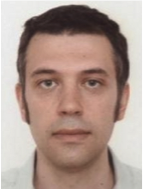 Konstantinos Samdanis is currently working as a Research Scientist at NEC Europe Ltd, Germany conducting research in the area of network management and Self-Organized Networks for eUTRAN and LTE-A, while he is also active in the field of energy efficient networking and green communication. Konstantinos is involved in 3GPP System Architecture Group 5 and in the Broadband Forum. He obtained a PhD in Mobile Communications and a MSc in Electronic Research from King’s College London at 2009 and 2003 respectively. Priory he studied Electrical and Electronic Engineering at Brunel University UK, with major in Telecommunication Systems. In the past he conducted market research at eGov Monitor UK and worked as a teaching assistant at King’s College London. Konstantinos Samdanis is currently working as a Research Scientist at NEC Europe Ltd, Germany conducting research in the area of network management and Self-Organized Networks for eUTRAN and LTE-A, while he is also active in the field of energy efficient networking and green communication. Konstantinos is involved in 3GPP System Architecture Group 5 and in the Broadband Forum. He obtained a PhD in Mobile Communications and a MSc in Electronic Research from King’s College London at 2009 and 2003 respectively. Priory he studied Electrical and Electronic Engineering at Brunel University UK, with major in Telecommunication Systems. In the past he conducted market research at eGov Monitor UK and worked as a teaching assistant at King’s College London.
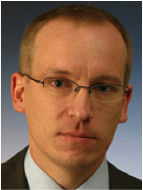 Dominique Dudkowski received his diploma in computer science in 2002 and his doctoral degree in mobile communications in 2009 from Stuttgart University, Germany. He worked as a research and teaching assistant in the Distributed Systems Group at University Stuttgart until he joined the Network Management Group of NEC Laboratories Europe in Heidelberg, Germany, in 2008. At the labs, he has been working on management principles and architectures for the future Internet and cloud networks within the large-scale EU projects 4WARD and SAIL. He is also developing energy-efficient solutions for large fixed networks, focusing on innovative data center energy management approaches based on OpenFlow technology. Dominique is a member of several technical program committees of key conferences and workshops that have emerged in green communications and networking in the past few years. He has been coordinating the First IEEE Online Conference on Green Communications, has been a panelist on energy measurement in communication networks and has been involved in standardization of Internet-related energy consumption monitoring. Dominique Dudkowski received his diploma in computer science in 2002 and his doctoral degree in mobile communications in 2009 from Stuttgart University, Germany. He worked as a research and teaching assistant in the Distributed Systems Group at University Stuttgart until he joined the Network Management Group of NEC Laboratories Europe in Heidelberg, Germany, in 2008. At the labs, he has been working on management principles and architectures for the future Internet and cloud networks within the large-scale EU projects 4WARD and SAIL. He is also developing energy-efficient solutions for large fixed networks, focusing on innovative data center energy management approaches based on OpenFlow technology. Dominique is a member of several technical program committees of key conferences and workshops that have emerged in green communications and networking in the past few years. He has been coordinating the First IEEE Online Conference on Green Communications, has been a panelist on energy measurement in communication networks and has been involved in standardization of Internet-related energy consumption monitoring.
Tutorial T7: Migration to Cloud: Transforming Enterprise Applications into Cloud Services
Friday, 1:45pm-5:15pm, April 20, 2012
Speakers: Kamal Bhattacharya (IBM Research, India), Choong Thio (IBM Global Technology Services, USA)
Abstract:
As Cloud is gaining significant traction in the industry, enterprises of today are considering Cloud as the delivery model of the future. The challenges however are significant: as with any transformational effort, the costs and risk associated with migration to Cloud present inhibitors that need to be overcome to make Cloud a really pervasive delivery model for enterprise application hosting. This tutorial will give an overview of various strategies to migrate applications to different Cloud models, focusing on IaaS but also elaborating on PaaS and SaaS scenarios. We will start by presenting various migration strategies focusing on Infrastructure as a Service targets. We will illustrate the pros and cons of various strategies from a cost and risk perspective. We will furthermore describe the impact of service management and QoS considerations on the migration scenarios. Finally, we will discuss how Cloud migration is different than regular data center transformation and application consolidation and why proper migration techniques can result in significant benefits over standard virtualization strategies.
Speakers' Biography:
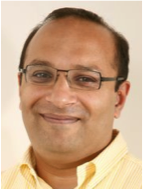 Kamal Bhattacharya is a Senior Manager at IBM Research - India, Bangalore and in the global IBM Services In novation Lab. His research is focused on topics around Cloud Computing, especially application migration to the Cloud, IT services delivery in the context of IT outsourcing and social computing in the enterprise. Before joining IBM Research - India he lead a team at IBM Watson Research, NY, US, exploring new ideas in the area of IT Optimization with a focus on data center consolidation and application migration. Prior to that he has been working as a Research Staff Member at Watson in the Model-driven Business Transformation team. He has received three IBM Outstanding Technical Achievement Award and several IBM Research Division awards for his work. Furthermore, he has received several best paper awards at international conferences for his contributions in the area of business process management and IT service management. He is an elected member of the IBM Academy of Technology. He has given numerous talks at universities in the US, Europe and India on Cloud computing and Migration. Kamal started his career at IBM as an IT architect at IBM Global Services in Germany. He graduated with a PhD in Theoretical Physics from the Georg-August University Goettingen, Germany, in 1999. Kamal Bhattacharya is a Senior Manager at IBM Research - India, Bangalore and in the global IBM Services In novation Lab. His research is focused on topics around Cloud Computing, especially application migration to the Cloud, IT services delivery in the context of IT outsourcing and social computing in the enterprise. Before joining IBM Research - India he lead a team at IBM Watson Research, NY, US, exploring new ideas in the area of IT Optimization with a focus on data center consolidation and application migration. Prior to that he has been working as a Research Staff Member at Watson in the Model-driven Business Transformation team. He has received three IBM Outstanding Technical Achievement Award and several IBM Research Division awards for his work. Furthermore, he has received several best paper awards at international conferences for his contributions in the area of business process management and IT service management. He is an elected member of the IBM Academy of Technology. He has given numerous talks at universities in the US, Europe and India on Cloud computing and Migration. Kamal started his career at IBM as an IT architect at IBM Global Services in Germany. He graduated with a PhD in Theoretical Physics from the Georg-August University Goettingen, Germany, in 1999.
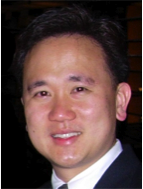 Choong Thio is currently a Senior Technical Staff Member in IBM GTS. He is the chief architect for the architecture, design and development of the GTS Cloud Migration Service for Smart Cloud Enterprise Plus. His expertise is primarily in the area of server virtualization, workload migration and transformation. Prior to that, he has been the lead senior manager for the OS Provisioning and Software Distribution area with GTS. He has received one IBM Outstanding Technical Achievement Award and has filed several patents in this area. He started his career at IBM as a software programmer in IBM Software Group in 1990. He graduated with a Masters in Computer Science from Stanford University in 1989. Choong Thio is currently a Senior Technical Staff Member in IBM GTS. He is the chief architect for the architecture, design and development of the GTS Cloud Migration Service for Smart Cloud Enterprise Plus. His expertise is primarily in the area of server virtualization, workload migration and transformation. Prior to that, he has been the lead senior manager for the OS Provisioning and Software Distribution area with GTS. He has received one IBM Outstanding Technical Achievement Award and has filed several patents in this area. He started his career at IBM as a software programmer in IBM Software Group in 1990. He graduated with a Masters in Computer Science from Stanford University in 1989.
Tutorial T8: Managing Converged IP and Optical Transport Networks: Current Trends and Future Challenges
Friday, 1:45pm-5:15pm, April 20, 2012
Speakers: Admela Jukan (Technische Universität Carolo-Wilhelmina zu Braunschweig, Germany), Xavi Masip (Technical University of Catalunya, Spain), Marcelo Yannuzzi (Technical University of Catalunya, Spain), Óscar González (Telefonica I+D, Spain), Maciej Maciejewski (ADVA Optical Networking, Poland)
Abstract:
In this tutorial, to goal is to address IP-optical transport convergence from the perspective of network management. To this end, we will give an overview of standard functions of network management in the Internet and optical networks, and their comparison. We will also discuss the role of control plane in the management functions. Throughout the tutorial we will pay equal attention to the commercial tools, device vendors, and open source management tools that implement the management systems and protocols. Finally, we will discuss the emerging multilayer network management systems, third party systems, and ongoing standards, such as the PCE and the MTOSI standard.
Speakers' Biography:
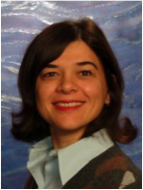 Admela Jukan is Chair Professor of Communication Networks in Electrical and Computer Engineering Department at the Technische Universität Carolo-Wilhelmina zu Braunschweig (Brunswick) in Germany. Prior to coming to Brunswick, she was research faculty at the Institut National de la Recherche Scientifique (INRS), University of Illinois at Urbana Champaign (UIUC) and Georgia Tech (GaTech). From 2002-2004, she served as Program Director in Computer and Networks System Research at the National Science Foundation (NSF) in Arlington, VA. She received the M.Sc. degree in Information Technologies from the Politecnico di Milano, Italy, and the Ph.D. degree (cum laude) in Electrical and Computer Engineering from the Technische Universität Wien, in Vienna, Austria. She received her B.Sc. (Dipl. -Ing.) degree from the Faculty of Electrical Engineering and Computing (FER), in Zagreb, Croatia. Dr. Jukan has chaired and co-chaired several international conferences, including IFIP ONDM, IEEE ANTS, IEEE ICC and IEEE GLOBECOM. She serves as Associate Technical Editor for IEEE Communications Surveys, IEEE Communications Magazine and IEEE Network. She serves as Secretary of the IEEE Optical Network Technical Committee (Vice Chair in 2012, Chair in 2014). She coordinates the EU project ONE, with focus on next generation converged IP-optical network management systems. She is a Senior Member of the IEEE. Admela Jukan is Chair Professor of Communication Networks in Electrical and Computer Engineering Department at the Technische Universität Carolo-Wilhelmina zu Braunschweig (Brunswick) in Germany. Prior to coming to Brunswick, she was research faculty at the Institut National de la Recherche Scientifique (INRS), University of Illinois at Urbana Champaign (UIUC) and Georgia Tech (GaTech). From 2002-2004, she served as Program Director in Computer and Networks System Research at the National Science Foundation (NSF) in Arlington, VA. She received the M.Sc. degree in Information Technologies from the Politecnico di Milano, Italy, and the Ph.D. degree (cum laude) in Electrical and Computer Engineering from the Technische Universität Wien, in Vienna, Austria. She received her B.Sc. (Dipl. -Ing.) degree from the Faculty of Electrical Engineering and Computing (FER), in Zagreb, Croatia. Dr. Jukan has chaired and co-chaired several international conferences, including IFIP ONDM, IEEE ANTS, IEEE ICC and IEEE GLOBECOM. She serves as Associate Technical Editor for IEEE Communications Surveys, IEEE Communications Magazine and IEEE Network. She serves as Secretary of the IEEE Optical Network Technical Committee (Vice Chair in 2012, Chair in 2014). She coordinates the EU project ONE, with focus on next generation converged IP-optical network management systems. She is a Senior Member of the IEEE.
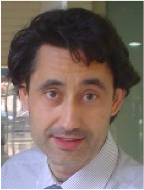 Xavi Masip, Ph.D. in Telecommunications Engineering from the UPC is currently an associate professor of Computer Science and Communications at the Technical University of Catalunya (UPC). From 1996 he has a long trajectory of participation on different national and European (FP6 IST LION, NOBEL, NOBEL II, EuQoS, E-NEXT, CONTENT) research projects. He has also led several research initiatives, national and international, as well as other contracts with institutions and industries. His research is also funded by Cisco Systems, through RFP and SRA contracts. He has authored around hundred of papers in international conferences and journals and has chaired or co- chaired several international conferences, such as IFIP ONDM, IFIP WWIC, NOC, IEEE IWIMC. In 2006 he founded the Advanced Network Architectures Lab (CRAAX) being currently the CRAAX director. His current research interests lie in broadband communications, QoS/QoE management and provision, and media networks architectures design. Xavi Masip, Ph.D. in Telecommunications Engineering from the UPC is currently an associate professor of Computer Science and Communications at the Technical University of Catalunya (UPC). From 1996 he has a long trajectory of participation on different national and European (FP6 IST LION, NOBEL, NOBEL II, EuQoS, E-NEXT, CONTENT) research projects. He has also led several research initiatives, national and international, as well as other contracts with institutions and industries. His research is also funded by Cisco Systems, through RFP and SRA contracts. He has authored around hundred of papers in international conferences and journals and has chaired or co- chaired several international conferences, such as IFIP ONDM, IFIP WWIC, NOC, IEEE IWIMC. In 2006 he founded the Advanced Network Architectures Lab (CRAAX) being currently the CRAAX director. His current research interests lie in broadband communications, QoS/QoE management and provision, and media networks architectures design.
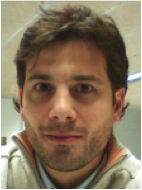 Marcelo Yannuzzi received a degree in electrical engineering from the University of the Republic, Uruguay, and the MSc and Ph.D. degrees in Computer Science from the Department of Computer Architecture (DAC), Technical University of Catalonia (UPC), Spain. He is the R&D head of the Advanced Network Architectures Lab (CRAAX) at the Technical University of Catalonia (UPC), where he leads several research initiatives in the area of network management, including projects funded by Cisco Systems, Inc., USA, and the European Commission under the FP7 research program. He held previous positions with the Physics Department of the School of Engineering, University of the Republic, Uruguay, and with the Electrical Engineering Department of the same School between 1997 and 2003. He worked at the national Telco in Uruguay, from 1993 to 2003, actively participating in the design and man agement of the largest IP network and IP-based services in Uruguay. His research interests are in the areas of management of IP and optical networks, cross-layer/cross-platform interactions and optimization, route control, autonomic computing, and the design of novel management paradigms in support of IT and network convergence. Marcelo Yannuzzi received a degree in electrical engineering from the University of the Republic, Uruguay, and the MSc and Ph.D. degrees in Computer Science from the Department of Computer Architecture (DAC), Technical University of Catalonia (UPC), Spain. He is the R&D head of the Advanced Network Architectures Lab (CRAAX) at the Technical University of Catalonia (UPC), where he leads several research initiatives in the area of network management, including projects funded by Cisco Systems, Inc., USA, and the European Commission under the FP7 research program. He held previous positions with the Physics Department of the School of Engineering, University of the Republic, Uruguay, and with the Electrical Engineering Department of the same School between 1997 and 2003. He worked at the national Telco in Uruguay, from 1993 to 2003, actively participating in the design and man agement of the largest IP network and IP-based services in Uruguay. His research interests are in the areas of management of IP and optical networks, cross-layer/cross-platform interactions and optimization, route control, autonomic computing, and the design of novel management paradigms in support of IT and network convergence.
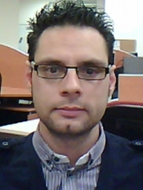 Óscar González de Dios received the MS from U. of Valladolid in 2000 in Telecommunications Engineering. Since 2000 he has been with TID, where he has worked for several years in the development and testing of telephony applications and interactive voice-response platforms. In 2005, he joined the Advanced Network Planning department in TID, working on the analysis and performance evaluation of optical networks. He has been active in manifold large scale R&D European IST projects, and CELTIC projects. He has coordinated the BANITS2 Celtic project. Óscar González de Dios received the MS from U. of Valladolid in 2000 in Telecommunications Engineering. Since 2000 he has been with TID, where he has worked for several years in the development and testing of telephony applications and interactive voice-response platforms. In 2005, he joined the Advanced Network Planning department in TID, working on the analysis and performance evaluation of optical networks. He has been active in manifold large scale R&D European IST projects, and CELTIC projects. He has coordinated the BANITS2 Celtic project.
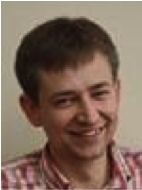 Maciej Maciejewski has been with ADVA Optical Networking since 2006, leading integration of network resources in the network management systems. He received MSc. in optoelectronics from the Gdansk University of Technology in 2002. His research interests include network resources virtualization and presentation."Maciej Maciejewski has been with ADVA Optical Networking since 2006, leading integration of network resources in the network management systems. He received MSc. in optoelectronics from the Gdansk University of Technology in 2002. His research interests include network resources virtualization and presentation. Maciej Maciejewski has been with ADVA Optical Networking since 2006, leading integration of network resources in the network management systems. He received MSc. in optoelectronics from the Gdansk University of Technology in 2002. His research interests include network resources virtualization and presentation."Maciej Maciejewski has been with ADVA Optical Networking since 2006, leading integration of network resources in the network management systems. He received MSc. in optoelectronics from the Gdansk University of Technology in 2002. His research interests include network resources virtualization and presentation.
|
|
- PROGRAM
- Keynotes >>
- Technical sessions >>
- Application sessions >>
- Poster sessions >>
- Panels >>
- Distinguished Experts
Panel >>
- Mini conference >>
- Workshops >>
- Tutorials >>
- Dissertation Digest Sessions >>
- Student Demos >>
- GOLD >>
|
|
